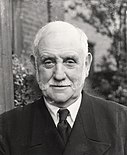From today's featured article
The second battle of Cape Finisterre was a naval encounter fought on 25 October 1747 during the War of the Austrian Succession. A British fleet of fourteen ships of the line commanded by Rear-Admiral Edward Hawke (depicted) intercepted a French convoy of 250 merchant ships protected by eight ships of the line commanded by Vice Admiral Henri-François des Herbiers. When the two forces sighted each other, Herbiers attempted to draw the British warships towards him. In this he was successful and the British enveloped the rear of the French line and brought superior numbers to bear on the French vessels one at a time. Six of the French warships were captured, along with 4,000 of their seamen. Of the 250 merchant ships, only 7 were captured. The British victory isolated the French colonies from supply and reinforcement. The war ended the following year and France recovered its colonial losses in return for withdrawing from its gains in the Austrian Netherlands. (Full article...)
Did you know ...
- ... that pioneer radiologist Sydney Domville Rowland coined the term "skiagraphy" (example pictured)?
- ... that in the 1920s, Hickson Inc. had the "most elegant and expensive specialty shop" on New York's Fifth Avenue?
- ... that the Konzerthalle in Bad Salzuflen, an example of spa architecture in the 1960s, is one of the regular venues of the Nordwestdeutsche Philharmonie?
- ... that Eppa Hunton Jr. and his son, Eppa Hunton IV, the namesakes of the Hunton Student Center at Virginia Commonwealth University, served a combined 50 years on the Medical College of Virginia's board of visitors?
- ... that a U.S. soldier who killed a Vietnamese woman after raping her was dubbed a "double veteran"?
- ... that both of Karl R. Free's New Deal-era U.S. post office murals with Native American subjects have been challenged as offensive?
- ... that the Scottish Register of Tartans has registered district tartans for Australia as a whole, and also a state district tartan for each of Australia's six states?
- ... that before bungee jumping with White House aides in New Zealand, senior White House correspondent Bill Plante said he was "proving that you're never too old to do something really stupid"?
In the news
- Rishi Sunak (pictured) succeeds Liz Truss as Leader of the Conservative Party and Prime Minister of the United Kingdom.
- Xi Jinping is named General Secretary of the Chinese Communist Party for a third term after the conclusion of the Party Congress.
- Ulf Kristersson is elected Prime Minister of Sweden following a four-party agreement.
- Hurricane Julia leaves more than 90 people dead across South and Central America.
On this day
- 1864 – American Civil War: During Price's Missouri Expedition, Union troops defeated Sterling Price's Confederate army in three successive battles: Marais des Cygnes, Mine Creek, and Marmiton River.
- 1932 – George Lansbury (pictured) became the leader of the opposition British Labour Party.
- 1950 – The People's Volunteer Army ambushed the South Korean II Corps at the Battle of Onjong, and elsewhere engaged the 1st Infantry Division at the Battle of Unsan, marking China's entry into the Korean War.
- 2001 – Windows XP, one of the most popular and widely used versions of the Microsoft Windows operating system, was released for retail sale.
- 2010 – Mount Merapi in Central Java, Indonesia, began an increasingly violent series of eruptions that lasted over a month.
- Catherine of Bosnia (d. 1478)
- Funmilayo Ransome-Kuti (b. 1900)
- Antonin Raymond (d. 1976)
Today's featured picture
|
The Old Royal Naval College is the architectural centrepiece of Maritime Greenwich, a World Heritage Site in Greenwich, London, described by the United Nations Educational, Scientific and Cultural Organization as the "finest and most dramatically sited architectural and landscape ensemble in the British Isles". The buildings were originally constructed to serve as the Royal Hospital for Seamen at Greenwich, now generally known as Greenwich Hospital, which was chartered by King William III and Queen Mary II on 25 October 1694, designed by Christopher Wren, and built between 1696 and 1712. The hospital closed in 1869. Between 1873 and 1998 it housed the Royal Naval College, Greenwich. This panoramic photograph depicts the two buildings of the Old Royal Naval College viewed from across the River Thames, with the Queen's House visible in the background in between. Photograph credit: Colin
Recently featured:
|
Other areas of Wikipedia
- Community portal – The central hub for editors, with resources, links, tasks, and announcements.
- Village pump – Forum for discussions about Wikipedia itself, including policies and technical issues.
- Site news – Sources of news about Wikipedia and the broader Wikimedia movement.
- Teahouse – Ask basic questions about using or editing Wikipedia.
- Help desk – Ask questions about using or editing Wikipedia.
- Reference desk – Ask research questions about encyclopedic topics.
- Content portals – A unique way to navigate the encyclopedia.
Wikipedia's sister projects
Wikipedia is written by volunteer editors and hosted by the Wikimedia Foundation, a non-profit organization that also hosts a range of other volunteer projects:
-
Commons
Free media repository -
MediaWiki
Wiki software development -
Meta-Wiki
Wikimedia project coordination -
Wikibooks
Free textbooks and manuals -
Wikidata
Free knowledge base -
Wikinews
Free-content news -
Wikiquote
Collection of quotations -
Wikisource
Free-content library -
Wikispecies
Directory of species -
Wikiversity
Free learning tools -
Wikivoyage
Free travel guide -
Wiktionary
Dictionary and thesaurus
Wikipedia languages
This Wikipedia is written in English. Many other Wikipedias are available; some of the largest are listed below.
-
1,000,000+ articles
-
250,000+ articles
-
50,000+ articles




